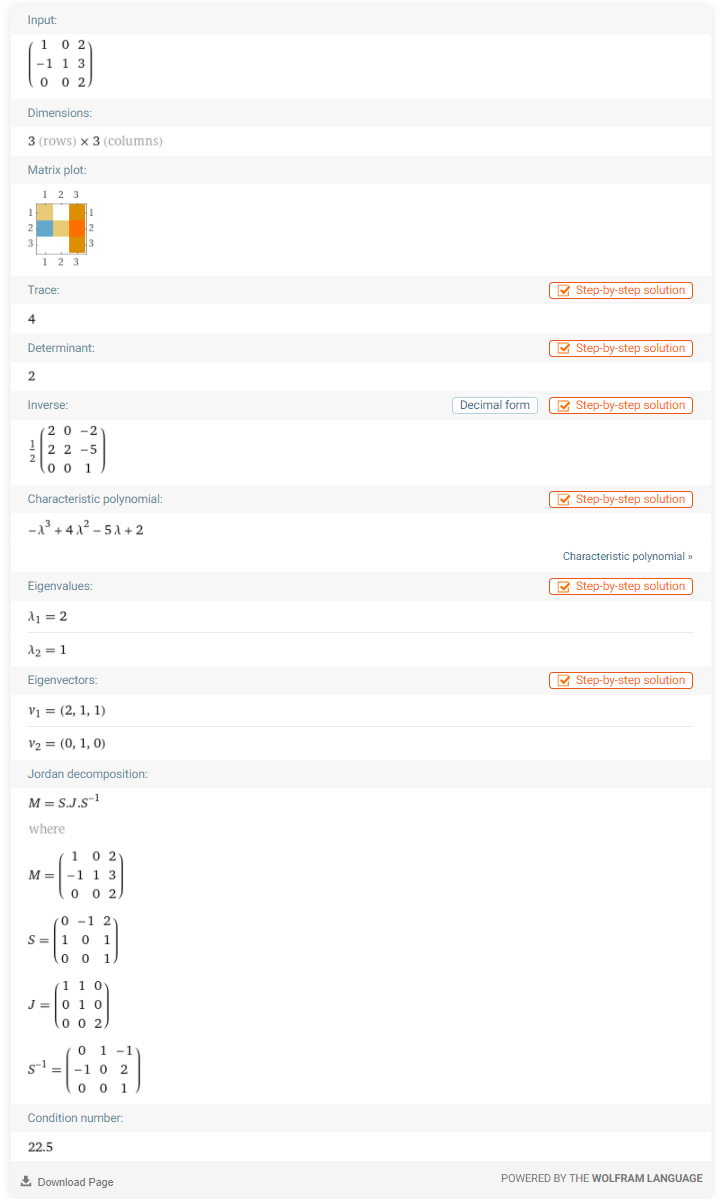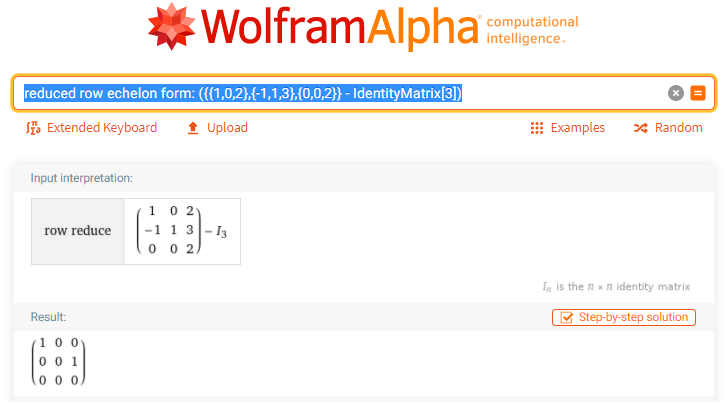The geometric multiplicity of an eigenvalue is the dimension of the linear space of its associated eigenvectors (i.e., its eigenspace).
You will find below a step-by-step tutorial that shows you how to find the geometric multiplicity of an eigenvalue with WolframAlpha, an incredibly useful web app that you can use as a linear-algebra calculator.
If you want to learn the theory in detail, you can visit our page on the Algebraic and geometric multiplicity of eigenvalues.
We will use WolframAlpha as a calculator.
Follow this link to open WolframAlpha in a new window.
The first thing to do is to find the eigenvalues of your matrix.
In this tutorial we are going to use the
matrix![[eq1]](/images/tutorial-how-to-find-geometric-multiplicity__1.png) as
an example.
as
an example.
In WolframAlpha, this matrix is written as {{1,0,2},{-1,1,3},{0,0,2}}. Copy this string in the WolframAlpha search box and hit Return.

Here is the result you get.

As you can see, the matrix has two eigenvalues:
and
.
If you know about Jordan forms, you
will immediately be able to see that the eigenvalue
is repeated only once on the main diagonal of the Jordan form
![[eq2]](/images/tutorial-how-to-find-geometric-multiplicity__5.png) Hence,
both the algebraic and geometric multiplicity of
Hence,
both the algebraic and geometric multiplicity of
are equal to
.
Instead, the eigenvalue
is repeated twice, which means that its algebraic multiplicity is equal to
.
Its geometric multiplicity is equal to the number of Jordan blocks associated
to
,
which is equal to
.
The general rule is: the geometric multiplicity of an eigenvalue is equal to the number of Jordan blocks associated to that eigenvalue.
Do not worry if you do not know about Jordan forms. In the next step, we are going to show how to find the geometric multiplicity without Jordan forms.
Let us focus on the eigenvalue
.
We know that an eigenvector
associated to
needs to
satisfy
where
is the
identity matrix.
The eigenspace of
is the set of all such eigenvectors. Denote the eigenspace by
.
Then,
![]()
The geometric multiplicity of
is the dimension of
.
Note that
is the null space of
.
By the rank-nullity
theorem, the
dimension of
must
be
![]() where
where
is the range of
.
In other words, the geometric multiplicity
can be found by calculating the dimension of the span of the columns of
.
But this can be easily done by computing the
reduced row echelon
form (rref) of
.
In WolframAlpha, the matrix
is written as {{1,0,2},{-1,1,3},{0,0,2}} - IdentityMatrix[3].
To compute its rref, copy the following string in the search box and press Enter:
reduced row echelon form: ({{1,0,2},{-1,1,3},{0,0,2}} - IdentityMatrix[3])
Here is the result you get.

As you can see, the rref of
has two basic columns, which implies that
![]()
As a consequence, the geometric multiplicity of
is
![]()
I guess we are done!
If you like this tutorial, please share this page with your friends, or link it from your blog.
Please cite as:
Taboga, Marco (2021). "Tutorial: how to find the geometric multiplicity of an eigenvalue", Lectures on matrix algebra. https://www.statlect.com/matrix-algebra/tutorial-how-to-find-geometric-multiplicity.
Most of the learning materials found on this website are now available in a traditional textbook format.